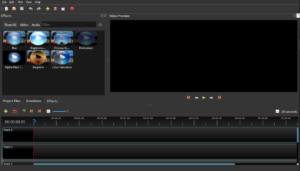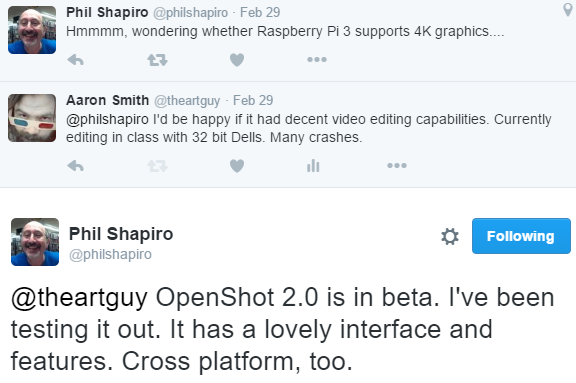 TL;DR: OpenShot is a free video editor that supports multiple tracks and chroma key. Try it out.
TL;DR: OpenShot is a free video editor that supports multiple tracks and chroma key. Try it out.
I’ve been an off-and-on-again fan of Linux for years (decades?), but one of the things that always had me come crawling back was the lack of decent video editing software. (And video games, but that’s another blog post.) (Yes I know about WINE, but it doesn’t work for everything and it adds extra steps that complicate things for younger students.) When I taught Visual Arts it wasn’t that big a deal, but now that I teach Media Arts, well, it’s kind of mandatory that I be able to edit video.
Now the word “decent” is rather important here. I’d tried some open source and web based video editors in the past, but of those that worked, none provided the features that I considered mandatory for a Media Arts classroom.
Then lo and behold, one day I had a Twitter conversation with Phil Shapiro. If you’re not following Mr. Shapiro, you might want to correct that mistake. He’s a librarian who frequently arms himself with metaphors and wordplay, making anyone’s Twitter timeline much better for the effort.
He is also the biggest proponent of open source software I’ve seen in a VERY long time, bragging about $20 laptops that he makes serviceable by removing Windows XP and replacing it with Linux Mint. (Although maybe a different flavor of Linux is in order now? I like PuppyLinux for very ancient machines, myself…)
In any case, Phil’s wit and love of all things maker/open source and my own laments about video editing led to this:

Wait, what’s this? A free video editor that doesn’t suck? I mean, HitFilm Express is free and quite good, but you still need to register an account to use it (ruling out most of my students as they are under 13), you get one install per person (ruling out my ability to install it on every computer in my lab), and it only runs on 64 bit machines (ALSO ruling out my ability to install it on all the things).
OpenShot has the same price tag as HitFilm and maybe not as many bells and whistles, but what it lacks in 3D composite shots it makes up for in its low-powered goodness. OpenShot easily handles multiple tracks of video and even does chroma key, which is something not frequently seen in a free editor.
![2016-05-23 10_52_01-Untitled Project [HDV 720 24p] - OpenShot Video Editor](https://academicaesthetic.com/wp-content/uploads/2016/05/2016-05-23-10_52_01-Untitled-Project-HDV-720-24p-OpenShot-Video-Editor.png) Like all software there is something of a learning curve, but for OpenShot the main hurdle is understanding that you right-click on a clip to split it at the play head. Most of the rest of it is quite intuitive.
Like all software there is something of a learning curve, but for OpenShot the main hurdle is understanding that you right-click on a clip to split it at the play head. Most of the rest of it is quite intuitive.
While OpenShot truly shines when run under Ubuntu Linux (32 bit Linux seems to make better use of system resources than 32 bit Windows, so programs like OpenShot have more room to stretch their legs), it also works reasonably well on Mac and Windows and, as it’s a free, open source program, there’s nothing preventing me from installing it on every computer in my lab.
Many of my students are still addicted to Camtasia in spite of its crashes (TechSmith tech support tells me it would edit HD video better if only I replaced my lab with 64 bit computers… Thanks, TechSmith.), but I hope to slowly wean them away from paid software and towards free and legal alternatives for the same reason that we’ve NEVER used an Adobe branded editor … ever.
I want students to be able to take what they learn in my class and be able to use it at home. Some of them have parents willing to spend $100 or more on software (or in the case of Adobe products, MUCH more than that as a subscription service so when you stop paying the software stops working), but most of them don’t. Those that do, I’d rather they invested that in nice hardware: computers, microphones, and cameras.
I’ll admit that when it comes to the Open Source movement I am far from a purist. My main draw (even now) is the idea that I can get something useful without having to pay an arm and a leg for it. Blame it on my salary as an educator, or perhaps my Visual Arts background (art teachers can make a lesson out of almost ANY material, particularly if it’s salvaged or donated), but if I can get it for free without breaking any laws, then I’m all for it.
OpenShot fits the bill for me. If you do anything that involves students editing video, you should try it out as well.
… now if only there was a decent way to edit video with a ChromeBook…

 Session 2: Fusing Media Technology and Content in the Classroom, by Margaret Olson
Session 2: Fusing Media Technology and Content in the Classroom, by Margaret Olson